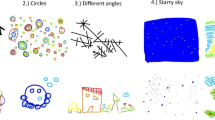Abstract
CHILDREN'S drawings raise formidable taxonomic problems. Consider the two extremely common drawings in Fig. 1. There are good reasons for selecting me ‘conventional man’ as a standard against which to assess the ‘tadpole man’ but we do not know how to do it. It may be that the tadpole man is lacking a trunk1–4 or that it has the trunk amalgamated with the head4,5 (and at least two other descriptions are also plausible). In practice, authors have tended to opt for the following subset of possible hypotheses: (1) the trunk is omitted and the arms attached according to a rule ‘attach arms to head’; (2) the trunk is omitted and the arms drawn on the head by default even though the child has a rule specifying the trunk as a locus of insertion for limbs; (3) the trunk is not differentiated from the head, and therefore the rule ‘attach arms to trunk’ is not violated. The present experiment was designed to test the plausibility of such accounts. Children were given incomplete figures and asked to draw limbs. The results show that the tendency to attach arms to the head or the trunk can be brought under lawful control in such a way as to discriminate against the above hypotheses in favour of one based on the concept of a ‘production error’.
Similar content being viewed by others
References
Lowenfeld, V., and Brittain, W. L., Creative and Mental Growth (Macmillan, New York, 1964).
Dileo, J. H., Young Children and their Drawings (Brunner, New York, 1970).
Machover, K., Personality Projection in the Drawing of the Human Figure (Thomas, Springfield, 1949).
Luquet, G. H., J. Psychol. norm. Path., 17, 684–710 (1920).
Arnheim, L., Art and Visual Perception (Faber, London, 1957).
Marasciulo, L. A., and McSweeney, M., Psych. Bull., 67, 401–412 (1967).
Goodenough, F. L., Measurement of Intelligence by Drawing (Harcourt, New York, 1926).
Snyder, R. T., and Gaston, D. S., J. clin. Psychol., 26, 377–383 (1970).
Hurlock, E. B., and Thompson, J. L., Child Dev., 5, 127–138 (1934).
Ames, L. B., and Ilg, F. L., Genet. Psychol. Monogr., 68, 247–307 (1963).
Shapiro, T., and Stine, J., Psychoanal. Study Child., 20, 298–309 (1965).
Kellogg, R., Analysing Children's Art (National, Palo Alto, 1970).
Goodnow, J. J., and Friedman, S., Devl Psychol., 7, 10–16 (1972).
Connolly, K., and Elliott, J., in Ethological Studies of Child Behaviour (edit. by Blurton-Jones, N.), 329–383 (Cambridge University Press, 1972).
Gesell, A., and Ames, L. B., J. genet. Psychol., 68, 45–61 (1946).
Freeman, N. H., Perception, 1, 123–140 (1972).
Author information
Authors and Affiliations
Rights and permissions
About this article
Cite this article
FREEMAN, N. Do children draw men with arms coming out of the head?. Nature 254, 416–417 (1975). https://doi.org/10.1038/254416a0
Received:
Revised:
Issue Date:
DOI: https://doi.org/10.1038/254416a0
- Springer Nature Limited





